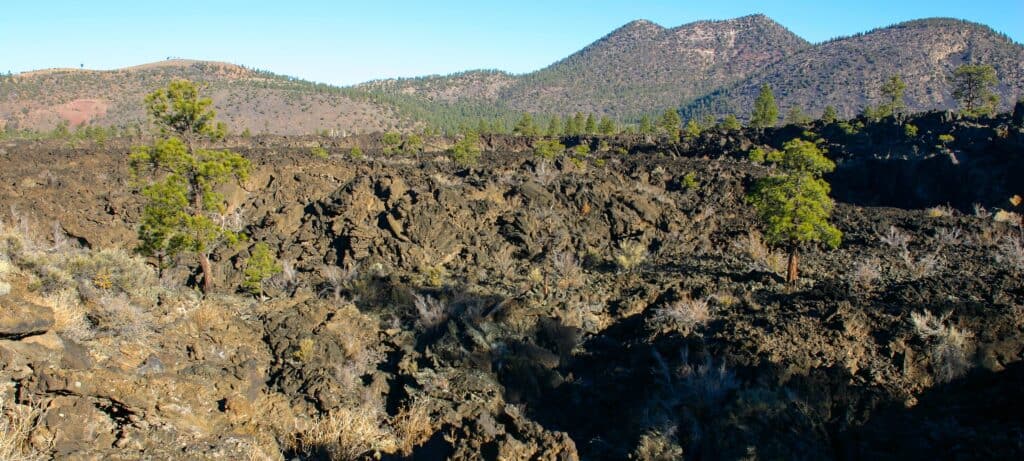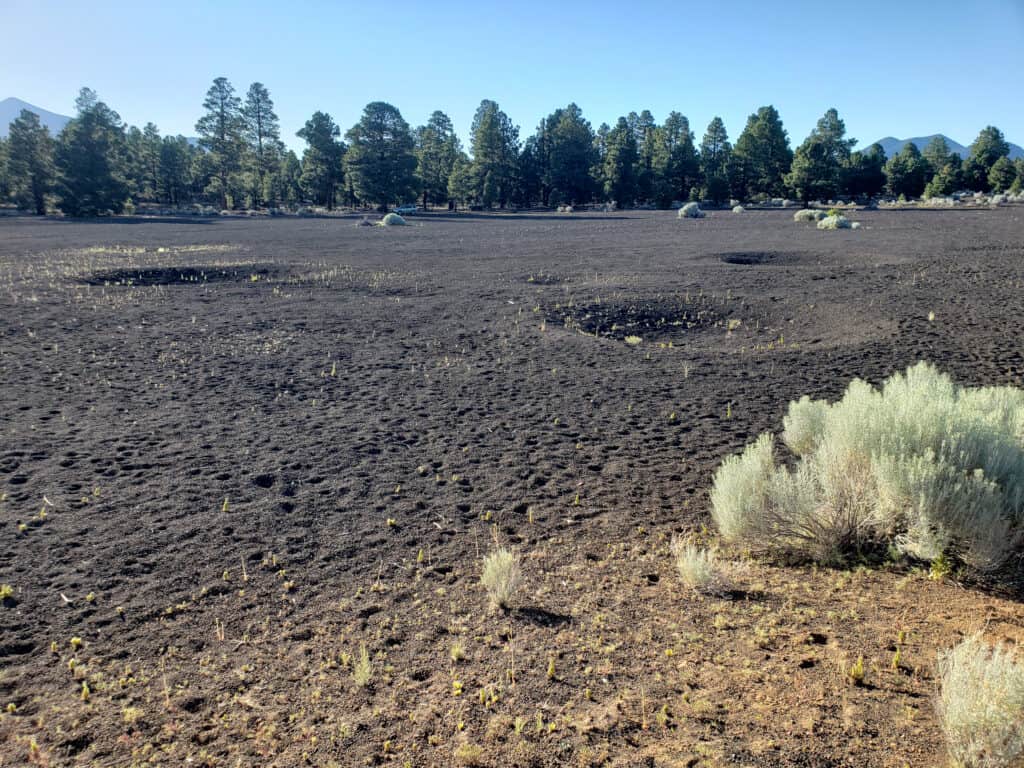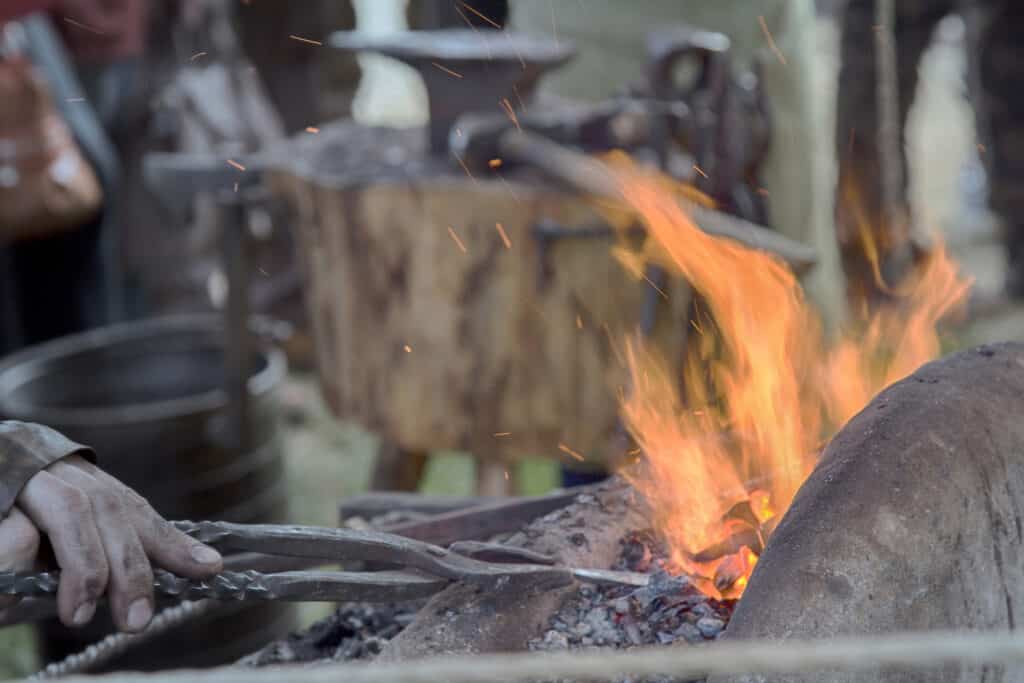Volcanoes in Arizona include more than 28 volcanic craters and 6 volcanoes or volcanic fields that house these craters. Craters are also known as calderas, and there are deposits of minerals found in some of these. Arizona is rich in copper thanks to the eruptions of its past and is known as the “Copper State” because of this.
A crater is formed down the top of a volcano and can be a deep or shallow pit. Sometimes, these craters fill with water, forming a lake. When they are shallow they’re called maars.
Types of Volcanoes in Arizona

Arizona was a hotbed of volcanic activity which now has many volcanic fields.
©Gerald Peplow/Shutterstock.com
Arizona is dry, arid land, and you wouldn’t be surprised to learn it used to be a hotbed of volcanic activity. There are 5 different types of volcanoes and before we dive into the Arizona volcanoes we’ll want to discuss a few of them. The main types are cinder cone, shield, stratovolcanoes, spatter cone, and complex volcanoes.
The only classifications that will truly matter in the discussion of volcanos in Arizona are cinder cone volcanoes and volcanic fields:
- Cinder cone volcanoes: grow upward into a cone shape made of loose pyroclastic material.
- Volcanic field: an area where volcanic activity is likely or has happened continuously over the years. They often form when volcanoes have deteriorated over time, but they still have volcanic activity. Frequently, they are dotted with many craters throughout and may even have a volcano in the active area.
Arizona’s Volcanic Fields

Cinder Lake Crater Field- Where the Apollo Astronauts trained is made of debris that erupted from the Sunset Crater around 1064 A.D.
©astro23/Shutterstock.com
Based on testing, these volcanic fields are younger than other fields in the United States. They are clusters of volcanoes in the area, connected by an old lava flow that has hardened and turned into impassable terrain over the years.
Tourists do often go to explore Arizona’s volcanic fields. There isn’t a risk of volcanic activity, and it is stunning to witness.
Hikers enjoy coming down and experiencing the aftermath of all this volcanic activity in the various volcanic fields. Let’s look at the six main areas and craters relevant in Arizona.
- Geronimo
- San Francisco Volcanic Field
- Sentinel Plain
- Springerville Volcanic Field
- Sunset Crater
- Uinkaret
Geronimo
The Geronimo volcanic fields stem originally from a cinder cone volcano. That makes sense because those are the ones that usually create a volcanic field as they shoot out a lot of debris and materials and spread out over time.
With shifting vents, it’s easy to see how a cinder cone volcano could create a volcanic field as it grew less powerful and eventually became extinct. According to scientists, Geronimo itself was last active around 3 million years ago.
There are 140 craters in the Geronimo volcanic fields. They all cover different vents from which magma could erupt. The magma stirs beneath the earth’s crust and uses the vents to release lava or gasses. Or at least it did, as there have been no eruptions in the last 10,000 years.
The craters located in these fields are also cinder cones, meaning they tend to look like large anthills. It is a site to see if ever in Arizona traversing across the volcanic fields.
This is an extinct volcano, meaning that it has not erupted in more than 10,000 years and isn’t likely to. Residents need not be concerned about any issues from this area any longer.
Active Volcanic Fields in Arizona
The two active volcanic fields in Arizona are San Francisco Volcanic Field and Uinkaret. Hearing that there are two active volcanic fields in Arizona can be scary, but it’s nothing to worry about currently. There are active volcanoes in Hawaii that have light, continuous eruptions that pose no real threat to people who live there.
If any of the volcanic fields in Arizona were to come to life, it would be like those eruptions in Hawaii. Beautiful, maybe a little miserable at times, but manageable. Dealing with the tourism industry would probably be harder for the state.
The 2 active volcanic fields in Arizona are the San Francisco Volcanic Field and Uinkaret. A volcanic field usually surrounds volcanoes and can have specialized activity. Not every crater is an active volcano, but the vents did emit magma at some point.
They are usually all venting from the same magma chamber, so they are grouped together. It’s fascinating how the earth adjusts itself over time and what it can create.
San Francisco Volcanic Field

Sunset Crater Volcano within the San Francisco Volcanic Field
©John G Rusfeldt/Shutterstock.com
The San Francisco Volcanic Field is in the Northern part of the state. It can boast a variety of volcanoes, in age from a thousand years to more than 6 million years old. Most of the hills found in this area are volcanoes, though most likely young ones.
This field is a national monument. You see, hikers love coming out in the spring and summer to explore the area. It covers 1800 miles, so there is always something for the tourists to discover.
There are more than 600 volcanoes in the San Francisco Volcanic Field. The area is so diverse that NASA has used it to manufacture different planet terrains. The San Francisco Mountain is 12,633 high and stands out among the other smaller volcanoes.
Sunset Crater is located in this volcanic field. Sunset Crater is a cinder cone volcano that many worry will erupt soon. It erupted 900 years ago and is not likely to erupt again at all. It is considered an utterly extinct volcano, according to scientists.
It’s not unusual to have an active volcanic field with extinct volcanoes. Imagine if all 600 volcanoes in a field were active. Science and history have shown that is unlikely.
The color of the material deposits decorating Sunset Crater gives it that name. They are oranges and yellows in color and were welded together during an eruption of the cinder cone volcano.
Uinkaret

Vulcan’s Forge is an extinct cinder cone volcano. Vulcan was the Roman God of the forge, of fire and patron of blacksmiths
©Maximillian cabinet/Shutterstock.com
The Uinkaret Volcanic Field is home to the famous Vulcan’s Throne and Vulcan’s Forge, two extinct cinder cone volcanoes. The Uinkaret Volcanic Fields are well known because they have impacted the Grand Canyon in the past. The lava flow has dammed it up and changed the landscape during the last eruptions by blocking the Colorado River.
The river is no longer dammed, but the remnants remain. There are two popular masses to visit when one is near Uinkaret. These include Vulcan’s Throne and Vulcan’s Forge.
Vulcan’s Throne is a cinder cone volcano created around 73,000 years ago. It is not an active volcano, even though it is situated on the edge of an active volcanic field.
Vulcan’s Forge is a volcano that came to life in the middle of the Colorado River. Now, all that remains is its vent, the opening that leads to the magma chamber below. It is part of what helped dam up the Colorado River so many years ago.
There are 213 volcanoes or vents found in Uinkaret, and the field is more than 3.5 million years old. There are volcanoes in the area that may have erupted as little as 500 years ago.
Vents that release the magma can merge into one if they are close enough and have lava flows simultaneously. That is part of what could end up ultimately making a volcano.
Sentinel Plain Volcanic Field
This volcanic field covers a short 372 miles and is not active. It’s situated within the Sentinel Plains themselves and has nothing particularly remarkable. Sentinal plain volcanic field was last active more than 10,000 years ago, making it extinct. It formed around 3 million years ago and likely hasn’t been active in 1.3 million years.
Springerville Volcanic Field
A bit more exciting, the Springerville Volcanic Field has more than 400 volcanoes covering its landscape and is the third largest volcanic field in the United States. It has not been active in 300,000 years and is extinct.
The type of volcano you’ll find in this volcanic field are cinder cones. They’re scattered throughout the 3,000 miles of field and built upward from the force of the blasts and the materials that produce them.
It’s wild to think of the landscape of Arizona a million years ago, dotted with volcanoes. Lava has made its mark all over the state, changing the ways that river flows, and altering the Grand Canyon.
Despite the danger volcanoes pose, they really can be marvelous spectacles, full of danger and substance. Over the years, they’ve altered the land we know. They help to explain why so much of the United States can boast such varying terrain and mountain ranges. Not everyone knows how genuinely volcanic activity has changed Arizona, and now you are one of the lucky few.
The photo featured at the top of this post is © mark stephens photography/Shutterstock.com
Thank you for reading! Have some feedback for us? Contact the AZ Animals editorial team.






